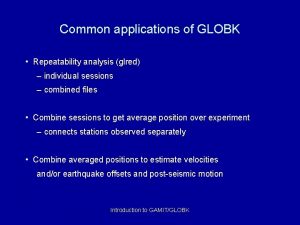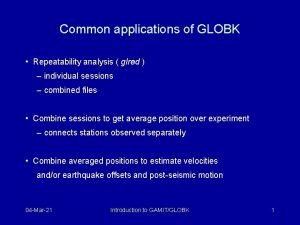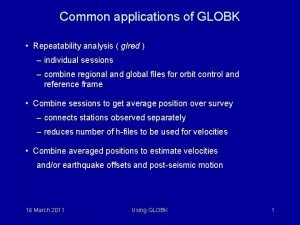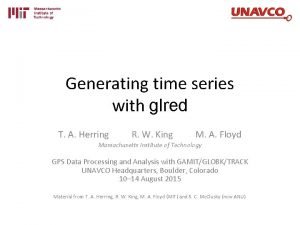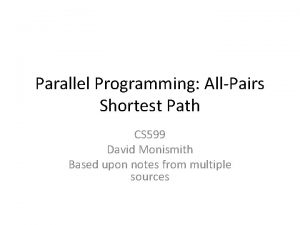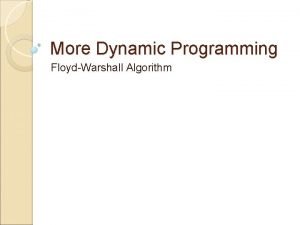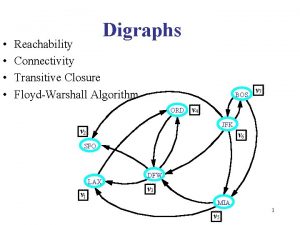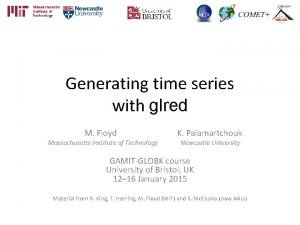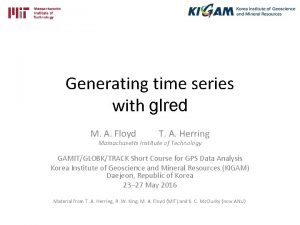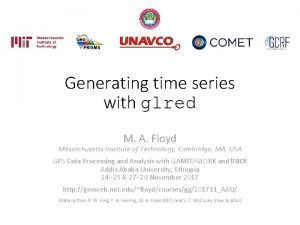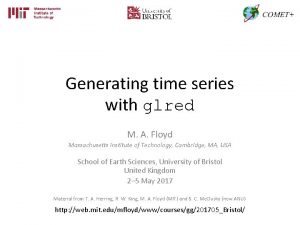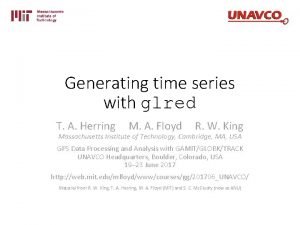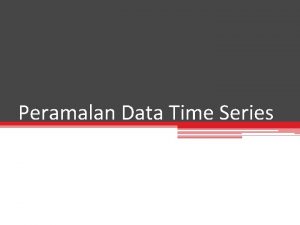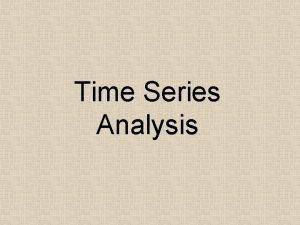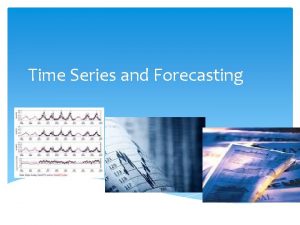Generating time series with glred M A Floyd


















- Slides: 18

Generating time series with glred M. A. Floyd Massachusetts Institute of Technology, Cambridge, MA, USA GPS Data Processing and Analysis with GAMIT/GLOBK Earth Observatory of Singapore 17– 21 July 2017 http: //geoweb. mit. edu/~floyd/courses/gg/201707_EOS/ Material from R. W. King, T. A. Herring, M. A. Floyd (MIT) and S. C. Mc. Clusky (now at ANU)

sh_glred • glred is just a way of invoking globk to process one day at a time; sh_glred is a script to invoke glred easily for a sequence of days • Once you’ve run sh_gamit for a sequence of days, you will have on each day an h-file of loosely constrained parameter estimates and covariances. If you have appropriately constructed command files for globk (globk_comb. cmd) and glorg (glorg_comb. cmd) in [expt]/gsoln/, you can obtain time series using sh_glred -expt [expt] -s [start yr] [start_doy] [stop yr] [stop doy] -opt H G T which will translate the GAMIT plain text h-files into GLOBK binary hfiles (H), run GLOBK (G) and run sh_plot_pos (T) • The lectures on GLOBK, references frames and survey-mode GPS will guide you in constructing the command files, and there are selfguided templates to make this easy 2017/07/18 Generating time series with glred 1

Manual sequence • htoglb (i. e. sh_glred -opt H) • Converts plain text h-files output from GAMIT to binary h-files (in glbf/) for input to GLOBK • ls • Create list of binary h-files to process (in gsoln/) • glist • Create chronological list of h-files to process and associated information • glred (i. e. sh_glred -opt G) • Create “. org”-file(s) with individual solutions • sh_plot_pos (i. e. sh_glred -opt T) • Create “. pos” (time series) file(s) and time series plots • globk • Create combined (or velocity) solution • glorg • Additional glorg runs for different reference frames 2017/07/18 Generating time series with glred 2

htoglb • Creates binary h-files for input to GLOBK • All metadata etc. carried forward from GAMIT • Not restricted to plain text h-files from GAMIT • May also use SINEX (Software INdependent EXchange format), GIPSY’s “stacov” files, etc. • But beware of constraints implicit in solutions from other software/processing runs! • For example, from glbf/ htoglb. /dev/null. . /[0 -3][0 -9]/h*a. * 2017/07/18 Generating time series with glred 3

GLOBK checks • List files to be processed by GLOBK, e. g. from gsoln/ ls. . /glbf/h*. glx > expt. glx. gdl • Run pre-processing checks using glist expt. glx. gdl 201407_NSFBay. sum +1 ~/gg/tables/itrf 08_comb. eq: A 201407_NSFBay. gdl • This will also calculate if any over-lapping h-files should be combined with glred (e. g. multiple networks on the same day) • Inspect any errors (e. g. site name clashes) 2017/07/18 Generating time series with glred 4

Create time series • glred simply runs the main program, globk, once per interval (e. g. daily) to combine data over that interval into one solution and one effective time series point glred 6 glred_20150811. prt glred_20150811. log 201407_NSFBay. gdl globk_long. cmd • Assess solution by looking at “POS STATISTICS” lines • Old example using sh_glred with “-opt E” creates: • “mb”-files (time series) with multibase • “psbase”-files (Post. Script) with sh_baseline • Updated, preferred method is sh_glred with “-opt T”: • tssum to create “. pos”-files (time series) • sh_plot_pos to create Post. Script plots • “. org”-file may be input to sh_plot_pos, which will run tssum for you, e. g. sh_plot_pos -f glred_YYYYMMDD. org -d figs. . . 2017/07/18 Generating time series with glred 5

Time series solution files Old scheme Current scheme • “. org”-file • ensum • “. org”-file • tssum • “VAL”-file (time series values) • “SUM”-file (statistics) • multibase • “mb”-files • “. pos”-files • tsfit • “. res”-files • sh_plot_pos • Time series plots • sh_baseline • Time series plots sh_plot_pos sh_plotcrd 2017/07/18 Generating time series with glred 6

Recommended strategy for stabilization • In the template files, globk_long. cmd and glorg_long. cmd: • default apr-file is ~/gg/tables/itrf 08_comb. apr • default eq-file is ~/gg/tables/itrf 08_comb. eq • default stab-file is ~/gg/tables/igb 08_hierarchy. stab_site • itrf 08_comb. apr is a combined apr-file, using many publicly available coordinate sources, all aligned to ITRF 2008 • itrf 08_comb. eq is the associated eq-file with defined discontinuities • equipment changes • earthquakes • etc. • igb 08_hierarchy. stab_site uses the established IGS core network hierarchy to choose stabilizing sites, e. g. • “ stab_site DRAO/BREW/NANO/ALBH/HOLB” means use DRAO if available in the solution (e. g. h-files), otherwise use BREW if available, otherwise use NANO, etc. • Equivalent files for ITRF 2014 (“itrf 14…”, “igs 14…”) now available 2017/07/18 Generating time series with glred 7

Inspect consistency of stabilization statistically • It is a good idea to have thought about your reference frame stabilization when setting up your experiment, e. g. sites. defaults, before running sh_gamit • Desire as many well-defined (e. g. IGS) sites as possible for redundancy • Recommended to use some of the sites (preferring the first column) in ~/gg/tables/igb 08_hierarchy. stab_site when selecting your processing network, e. g. additional sites listed in your sites. defaults • But remember trade-off with processing time, e. g. processing time scales proportionally to n 3 grep ‘^POS S’ glred_20150811. org POS STATISTICS: For 51 Ref. Sites WRMS ENU 2. 15 2. 55 6. 19 mm NRMS ENU 0. 71 0. 84 0. 63 L 0104260000_tg 1 a. glx POS STATISTICS: For 54 Ref. Sites WRMS ENU 2. 17 2. 42 6. 03 mm NRMS ENU 0. 74 0. 80 0. 63 L 0104270000_tg 1 a. glx POS STATISTICS: For 50 Ref. Sites WRMS ENU 2. 12 2. 25 6. 34 mm NRMS ENU 0. 71 0. 75 0. 67 L 0104280000_tg 1 a. glx POS STATISTICS: For 54 Ref. Sites WRMS ENU 2. 19 2. 31 5. 23 mm NRMS ENU 0. 80 0. 81 0. 58 L 0104300000_tg 1 a. glx POS STATISTICS: For 54 Ref. Sites WRMS ENU 1. 83 2. 17 6. 34 mm NRMS ENU 0. 64 0. 75 0. 68 L 0105010000_tg 1 a. glx POS STATISTICS: For 54 Ref. Sites WRMS ENU 2. 09 2. 63 6. 47 mm NRMS ENU 0. 80 0. 98 0. 75 L 0105020000_tg 1 a. glx 2017/07/18 Generating time series with glred 8

“. pos”-files • These contain your time series solution • Long format in various coordinate systems • Geocentric (X, Y, Z) • Geodetic (lon. , lat. , height) • Local (east, north, up) • Can be input to tsfit (interactive version of GGMatlab tool “tsview”), sh_cats (requires CATS) and sh_hector (requires Hector) • Both “. pos”-files and “. res”-files can be plotted with sh_plot_pos 2017/07/18 Generating time series with glred 9

sh_plot_pos • Uses GMT and has many features including options to: • Read in “. org”-files, “. pos”-files (output of tssum) and “. res”-files (output of tsfit) [-f option] • Run tsfit (GLOBK’s curve-fitting module) on input “. pos”-files [-t option] • Calculate basic statistics (e. g. WRMS, NRMS) • Add vertical lines at epochs specified by renames, earthquakes or user [-b, -e and -l options, respectively] • Specify fixed start and end times of time series [-t 1, -t 2 options] • etc. 2017/07/18 Generating time series with glred 10

Inspect consistency of time series Good repeatability 2017/07/18 Outlier Generating time series with glred 11

Some “outliers” may be stability issues 2017/07/18 Generating time series with glred 12

Excluding outliers or segments of data • Create “rename” file records and add to GLOBK command file’s “eq_file” option, e. g. rename PTRB rename ABCD PTRB_XPS h 1407080610_nb 4 a PTRB_XPS 2014 07 07 18 00 2014 07 08 18 30 ABCD_XCL 2013 07 08 00 00 • “XPS” will not exclude data from glred (so still visible in time series) but will exclude data from globk (combination or velocity solution) • “XCL” will exclude data from all glred and globk runs 2017/07/18 Generating time series with glred 13

Iterating your solution • First time series may only be stabilized by previously well-defined sites, e. g. ITRF sites • Once a high-quality position (and velocity) estimate for a previously unknown or new site is available, we can use all sites to stabilize • This approach may be used with both time series (e. g. glred) and velocity (e. g. globk) solutions 2017/07/18 Generating time series with glred 14

Short- v long-term time series • Exactly the same procedure is used for short (e. g. survey) and long (e. g. years of continuous data) time series • The only difference may be the number and type of input h-files, e. g. • • Daily survey h-files (short-term time series) Combine into one solution (short-term position combination) Several combined survey files over years (long-term time series) Several combined survey files over years (long-term velocity combination) 2017/07/18 Generating time series with glred 15

tsfit and tsview • tsfit is the command-line tool for fitting time series and generating statistics • Input “. pos”-files, optionally eq-files • Fits linear rate and choice of common parameters • Periodic terms • Discontinuities and earthquakes • Post-seismic decays • Outputs • • statistics of fit standard (position and velocity) apr-files extended (periodic, logarithmic decay, etc. ) apr-files Residuals to fit (“. res”-files) • tsview is an alternative that, via a MATLAB interface, allows interaction 2017/07/18 Generating time series with glred 16

Summary • sh_glred is post-processing equivalent to sh_gamit • . pos-file format now standard GLOBK output for time series • Visual inspection of time series very important for identifying outliers, bad segments of data or other problems like incompatible site IDs • sh_plot_pos (GMT) and tsview (MATLAB) • Populate eq-file(s) with “rename” commands or use “sig_neu” commands to mitigate impact of poor or incompatible data points during velocity • Be aware that some “outliers” may be stabilization issues if they persist across a large part or all of a network at the same time, so check stabilization using “POS STATISTICS” lines in. org-file(s) • Numbers of stabilizing sites should be consistent and at least as many as the number of parameters estimated in glorg (e. g. three components of rotation and translation) • Numbers for wrms should be consistent from day-to-day and small (< 5 mm) • Batch tools are available for longer, denser, continuous time series where point-by-point visual inspection is unreasonable • tsfit and tsview 2017/07/18 Generating time series with glred 17
 Glred
Glred Glred
Glred Glred
Glred Glred
Glred Start time, end time and elapsed time
Start time, end time and elapsed time Maclaurin series vs taylor series
Maclaurin series vs taylor series Heisenberg 1925 paper
Heisenberg 1925 paper Maclaurin series vs taylor series
Maclaurin series vs taylor series Taylor frederick
Taylor frederick Ibm p series vs i series
Ibm p series vs i series Series series feedback amplifier
Series series feedback amplifier Series aiding and series opposing
Series aiding and series opposing Arithmetic sequence sum formula
Arithmetic sequence sum formula Jeff wittel eye
Jeff wittel eye The blanket by floyd dell
The blanket by floyd dell Floyd's algorithm pseudocode
Floyd's algorithm pseudocode Floydwarshall
Floydwarshall Electronic devices floyd 10th edition
Electronic devices floyd 10th edition Strongly connected
Strongly connected
